Abstract
Pentraxins are a superfamily of conserved proteins that are characterized by a cyclic multimeric structure1. The classical short pentraxins, C-reactive protein (CRP) and serum amyloid P component (SAP), are acute-phase proteins produced in the liver in response to inflammatory mediators2,3,4. Short pentraxins regulate innate resistance to microbes and the scavenging of cellular debris and extracellular matrix components2,3,4,5. In contrast, long pentraxins have an unrelated, long amino-terminal domain coupled to the carboxy-terminal pentraxin domain, and differ, with respect to short pentraxins, in their gene organization, chromosomal localization, cellular source, and in their stimuli-inducing and ligand-recognition ability6. To investigate the in vivo function of the long pentraxin PTX3, we generated mice deficient in Ptx3 by homologous recombination. Ptx3-null mice were susceptible to invasive pulmonary aspergillosis. Ptx3 binds selected microbial agents, including conidia of Aspergillus fumigatus, and we found that susceptibility of Ptx3-null mice was associated with defective recognition of conidia by alveolar macrophages and dendritic cells, as well as inappropriate induction of an adaptive type 2 response. Thus, the long pentraxin Ptx3 is a secreted pattern-recognition receptor that has a non-redundant role in resistance to selected microbial agents, in particular to the opportunistic fungal pathogen Aspergillus fumigatus.
This is a preview of subscription content, access via your institution
Access options
Subscribe to this journal
Receive 51 print issues and online access
$199.00 per year
only $3.90 per issue
Buy this article
- Purchase on Springer Link
- Instant access to full article PDF
Prices may be subject to local taxes which are calculated during checkout



Similar content being viewed by others
References
Emsley, J. et al. Structure of pentameric human serum amyloid P component. Nature 367, 338–345 (1994)
Szalai, A. J., Agrawal, A., Greenhough, T. J. & Volanakis, J. E. C-reactive protein structural biology, gene expression, and host defense function. Immunol. Res. 16, 127–136 (1997)
Steel, D. M. & Whitehead, A. S. The major acute phase reactants: C-reactive protein: serum amyloid P component and serum amyloid A protein. Immunol. Today 15, 81–88 (1994)
Pepys, M. B. & Baltz, M. L. Acute phase proteins with special reference to C-reactive protein and related proteins (pentaxins) and serum amyloid A protein. Adv. Immunol. 34, 141–212 (1983)
Noursadeghi, M. et al. Role of serum amyloid P component in bacterial infection: protection of the host or protection of the pathogen. Proc. Natl Acad. Sci. USA 97, 14584–14589 (2000)
Mantovani, A., Garlanda, C. & Bottazzi, B. Cytokine Reference (eds Oppenheim, J. & Feldmann, M.) (Academic, New York, 2002)
Breviario, F. et al. Interleukin-1-inducible genes in endothelial cells. Cloning of a new gene related to C-reactive protein and serum amyloid P component. J. Biol. Chem. 267, 22190–22197 (1992)
Lee, G. W., Lee, T. H. & Vilcek, J. TSG-14, a tumour necrosis factor- and IL-1-inducible protein, is a novel member of the pentaxin family of acute phase proteins. J. Immunol. 150, 1804–1812 (1993)
Vidal Alles, V. et al. Inducible expression of PTX3, a new member of the pentraxin family, in human mononuclear phagocytes. Blood 84, 3483–3493 (1994)
Introna, M. et al. Cloning of mouse PTX3, a new member of the pentraxin gene family expressed at extrahepatic sites. Blood 87, 1862–1872 (1996)
Bottazzi, B. et al. Multimer formation and ligand recognition by the long pentraxin PTX3 - similarities and differences with the short pentraxins C-reactive protein and serum amyloid P component. J. Biol. Chem. 272, 32817–32823 (1997)
Rovere, P. et al. The long pentraxin PTX3 binds to apoptotic cells and regulates their clearance by antigen-presenting dendritic cells. Blood 96, 4300–4306 (2000)
Lee, G. W., Goodman, A. R., Lee, T. H. & Vilcek, J. Relationship of TSG-14 protein to the pentraxin family of major acute phase proteins. J. Immunol. 153, 3700–3707 (1994)
Varani, S. et al. Knockout of pentraxin 3, a downstream target of growth differentiation factor-9, causes female subfertility. Mol. Endocrinol. 16, 1154–1167 (2002)
Medzhitov, R. Toll-like receptors and innate immunity. Nature Rev. Immunol. 1, 135–145 (2001)
Denning, D. W. Invasive aspergillosis. Clin. Infect. Dis. 26, 781–803 (1998)
Cenci, E. et al. Th1 and Th2 cytokines in mice with invasive aspergillosis. Infect. Immun. 65, 564–570 (1997)
Mencacci, A. et al. Defective antifungal T-helper 1 (TH1) immunity in a murine model of allogeneic T-cell-depleted bone marrow transplantation and its restoration by treatment with TH2 cytokine antagonists. Blood 97, 1483–1490 (2001)
Schaffner, A., Douglas, H. & Braude, A. Selective protection against conidia by mononuclear and against mycelia by polymorphonuclear phagocytes in resistance to Aspergillus. Observations on these two lines of defense in vivo and in vitro with human and mouse phagocytes. J. Clin. Invest. 69, 617–631 (1982)
Romani, L. The T cell response against fungal infections. Curr. Opin. Immunol. 9, 484–490 (1997)
Mencacci, A. et al. Cytokines in candidiasis and aspergillosis. Curr. Pharm. Biotechnol. 1, 235–251 (2000)
Bozza, S. et al. Dendritic cells transport conidia and hyphae of Aspergillus fumigatus from the airways to the draining lymph nodes and initiate disparate Th responses to the fungus. J. Immunol. 168, 1362–1371 (2002)
Botto, M. et al. Homozygous C1q deficiency causes glomerulonephritis associated with multiple apoptotic bodies. Nature Genet. 19, 56–59 (1998)
Peri, G. et al. PTX3, a prototypic long pentraxin, is an early indicator of acute myocardial infarction in man. Circulation 102, 636–641 (2000)
Muller, B. et al. Circulating levels of the long pentraxin PTX3 correlate with severity of infection in critically ill patients. Crit. Care Med. 29, 1404–1407 (2001)
Villa, P. et al. Pattern of cytokines and pharmacomodulation in sepsis induced by cecal ligation and puncture compared with that induced by endotoxin. Clin. Diagn. Lab. Immunol. 2, 549–553 (1995)
Watanabe, Y., Mitsuyama, M., Sano, M., Nakano, H. & Nomoto, K. Enhanced resistance against Listeria monocytogenes at an early phase of primary infection in pregnant mice: activation of macrophages during pregnancy. Infect. Immun. 52, 730–735 (1986)
Acknowledgements
This work was supported by Istituto Superiore di Sanità, Ministero Istruzione, Università e Ricerca (MIUR), Consiglio Nazionale della Richerche (CNR), and by the European Commission. We acknowledge the contribution of the Italian Association for Cancer Research. We thank C. Scotton for critical reading of the manuscript.
Author information
Authors and Affiliations
Corresponding author
Ethics declarations
Competing interests
R.D.S. and P.C. are employees of Sigma Tau, interested in exploiting the therapeutic potential of Ptx3. C.G., B.B., G.P. and A.M. are inventors in patent applications concerning Ptx3.
Rights and permissions
About this article
Cite this article
Garlanda, C., Hirsch, E., Bozza, S. et al. Non-redundant role of the long pentraxin PTX3 in anti-fungal innate immune response. Nature 420, 182–186 (2002). https://doi.org/10.1038/nature01195
Received:
Accepted:
Issue Date:
DOI: https://doi.org/10.1038/nature01195
This article is cited by
-
Immune responses to human fungal pathogens and therapeutic prospects
Nature Reviews Immunology (2023)
-
The clinical spectrum of aspergillosis in chronic obstructive pulmonary disease
Infection (2023)
-
Humoral Immunity Against Aspergillus fumigatus
Mycopathologia (2023)
-
Recipient and donor PTX3 rs2305619 polymorphisms increase the susceptibility to invasive fungal disease following haploidentical stem cell transplantation: a prospective study
BMC Infectious Diseases (2022)
-
Vasculature atrophy causes a stiffened microenvironment that augments epidermal stem cell differentiation in aged skin
Nature Aging (2022)
Comments
By submitting a comment you agree to abide by our Terms and Community Guidelines. If you find something abusive or that does not comply with our terms or guidelines please flag it as inappropriate.



